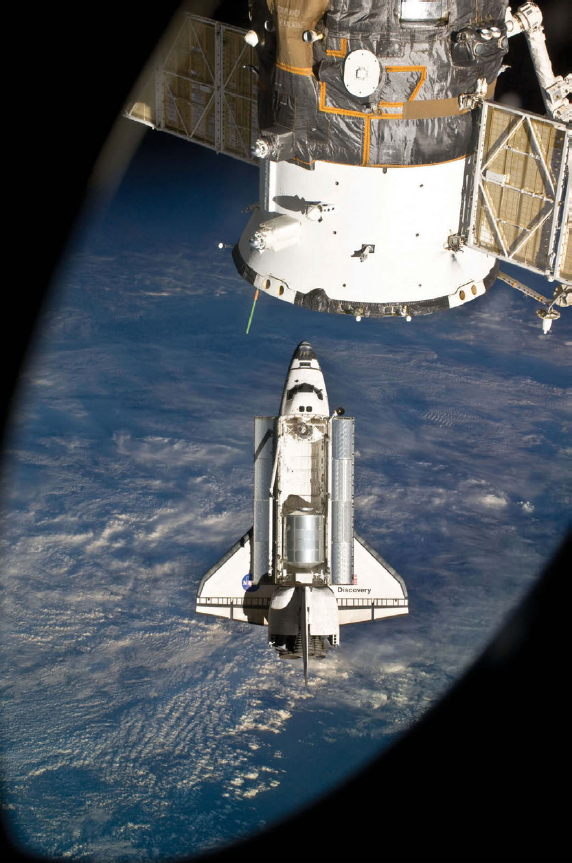1
The Evolution of the U.S. Astronaut Program
In the half century since the flight of Yuri Gagarin, more than 500 people have orbited Earth, of which 24 traveled to the Moon. Approximately 61 percent have been Americans.
With the exception of a handful of self-funded spaceflight participants, Soviet Union guest cosmonauts, and U.S. shuttle-era payload specialists, those astronauts have all traveled a relatively common road through the mission selection process. Each was subjected to rigorous medical and psychological screening, basic training in common academic classroom technical subjects, systems training in the spacecraft being flown, integrated emergency procedures, and crew-related team building exercises. They also transferred their technical knowledge and training into the design of the vehicles they flew and into the orbital operation of complex scientific and engineering research equipment and experiments. They have been considered not just operators but integral participants in the development and testing of new technologies and vehicles. In addition, they were exposed to both psychologically and physically stressful environments during training and in the flight environment. Before venturing to the launch pad, each professional would-be astronaut or cosmonaut endured survival training—the jungles, mountains, or water—and some mastered the art of parachute jumping or logged hundreds of hours of flight in high-performance aircraft, all with the goal of being able to perform in highly stressful and unusual environments.
Since 1961, U.S. astronauts have trained on and flown seven spacecraft systems, walked on the Moon, assembled a space station, retrieved satellites, launched and repaired the Hubble Space Telescope and other satellites, and trained on and executed thousands of scientific and engineering research experiments. Now, with the end of the Space Shuttle program and its unique training requirements, the NASA Johnson Space Center FCOD and the Mission Operations Directorate (MOD) Training Division are reviewing astronaut staffing and training facilities for the future. Future requirements for support of the International Space Station (ISS) are being coordinated with the ISS international partners, but commercial spaceflight and space exploration beyond low Earth orbit remain undefined. This transitional period creates uncertainty and challenges for NASA in determining the best staffing size for the Astronaut Corps.
HISTORY OF THE SIZE OF THE NASA ASTRONAUT CORPS
The number of astronauts qualified to fly in space as part of the Astronaut Corps has varied primarily as a function of the active flight program flight rate and vehicle crew size capability (Table 1.1). In the early 1960s, the Astronaut Corps started with seven astronauts during the Mercury program and grew to a high of nearly 150
TABLE 1.1 U.S. Human Spaceflight Programs
| Program Name | Vehicle Development | Flight Operations | Number of Flights | Crew Size | |
| Mercury | 1958-1961 | 1961-1963 | 6 | 1 | |
| Gemini | 1958-1965 | 1965-1966 | 10 | 2 | |
| Apollo | 1960-1968 | 1968-1975 | 12 | 3 | |
| Skylab Space Stationa | 1966-1973 | 1973-1974 | 3 | 3 | |
| Space shuttle | 1972-1981 | 1981-2011 | 135 | 2-8 | |
| Space shuttle-Mirb | 1995-1998 | 9 | 7+ | ||
| International Space Stationc | 1993-2011 | 1998-TBD | 27 | 3-6 | |
| Constellation Explorationd | 2004-2011 | Canceled | 0 | ||
| Orion/multipurpose crew vehicle | 2005-? | NLT 2016? | 0 | 4 | |
aFirst long-duration missions for the United States. Longest of 84 days set world record and established high standard of biomedical data for long-duration missions.
bDocking between the space shuttle and the Russian Space Station, Mir. Flight of U.S. astronauts on Russian Soyuz to Mir and Russian cosmonauts onboard the space shuttle. Seven astronauts were left on the Mir for long-duration missions (greater than 90 days). Program used existing Astronaut Corps (no new selections) but required new vehicle training on Russian Soyuz and Mir Space Station and Russian language training. In addition, shuttle crews were trained in docking operations with Mir. All Russian vehicle training was executed at Gagarin Cosmonaut Training Center in Star City, Russia.
cFlight is defined as “increment,” which is a multimonth mission and separated from the vehicle used to reach or return from the ISS.
dThe Exploration Program to the Moon and Mars was canceled in 2010, but the Astronaut Office had been closely involved in requirements and design.
at the peak of space shuttle flights and preparation for the ISS in 2000. Vehicle habitable volume and flight rate also increased. The Mercury capsule flew with a crew of one, and the later space shuttle could accommodate a maximum crew of eight. The ISS hosts an international crew of six. The current size of the active U.S. Astronaut Corps is 61, and an additional nine astronauts are in training (astronaut candidates, referred to as ASCANs). NASA has projected a minimum required Astronaut Corps size of 55 to 60 astronauts through 2016.
The size of the Astronaut Corps has historically been aligned not just with the spacecraft being flown at the time but with future human spaceflight programs in development but not yet flying. Because of the lead time required to train an astronaut through a basic and then a mission-specific training syllabus—often up to 4 years for the ISS—the Astronaut Office and the Mission Operations Training Division were required to develop reliable forecasting algorithms for personnel and facilities. The forecasts also typically tried to accommodate anticipated astronaut attrition due, for example, to retirements, large gaps in flight opportunities, health issues, and, more recently, lifetime radiation limits and Russian anthropometric size requirements.
The U.S. human spaceflight program history, from program development to flight operations, is summarized in Table 1.1. The table does not reflect the current dependence on the Russian Soyuz capsule (three cosmonauts) to reach the International Space Station after shuttle retirement. With retirement of the space shuttle, flights of U.S. astronauts to the ISS will decrease from about 28 a year to fewer than 6. However, the time to train for a mission increases from approximately 1 year for a shuttle to 3-4 years for the ISS. Furthermore, individual astronauts will not be able to fly as frequently on the ISS as on the space shuttle, because of lifetime radiation dose limits currently imposed on them.
The Mercury, Gemini, and Apollo programs required that a full backup crew be trained for each flight. The backup astronauts were required when medical problems, or even death, affected the crew manifest. The early schedules were driven by the Cold War space race, so resources were available to support the missions fully.
Backup crew members were used in the early flights of the space shuttle (STS-1 through STS-4), when the
crew was limited to two. However, when the flights expanded to four and later to five and then eight, it was decided to cross-train on the same flight for many of the functions because there were not enough astronauts and training resources to fully provide for backup crews. Two pilots with dual shuttle controls provided redundancy in space shuttle landing, which turned out not to have been needed. Mission specialists were generally cross-trained for on-orbit operations, with two notable exceptions: the flight engineer position (MS2) and for extravehicular activity (EVA), which required suits of a particular size. Each space shuttle flight required at least two astronauts qualified for EVA. EVA is also a requirement on the ISS. During this period, if an astronaut had to be replaced, it was assumed that an astronaut who had flown would be drawn from those awaiting their next flight assignment (Figure 1.1).
In addition, the composition of the Astronaut Corps has evolved substantially as well, and the current corps is a technically diverse group of people who have widely varied backgrounds and experience. The astronaut program began with only military test pilots, progressed to include scientist-astronauts during Apollo and Skylab, and now is composed of test pilots and mission specialists (engineers, scientists, and physicians) and educators and international partner astronauts sent by their home agencies to train alongside their U.S. colleagues.
The major changes in the professional Astronaut Corps have corresponded with the introduction of new spacecraft designs, with the addition of research to the mission objectives, and with the adoption of new policy goals for the nation’s human spaceflight programs. The Space Shuttle program, by design, was opened to women and a more technically diverse set of engineers and scientists (mission specialist astronauts and payload specialists).
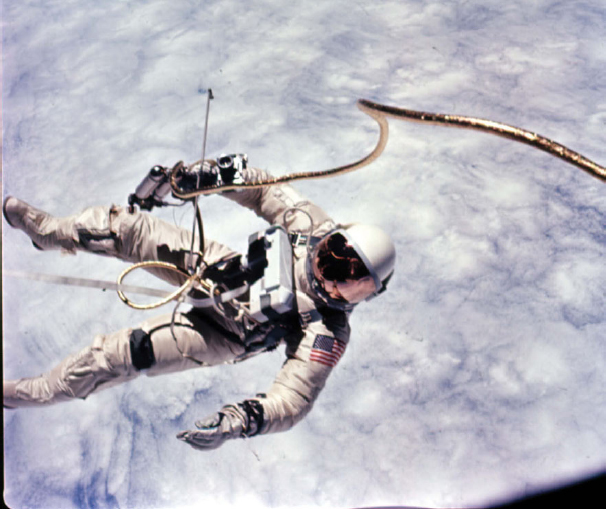
FIGURE 1.1 The first U.S. spacewalk was performed by Ed White during the Gemini 4 mission on June 3, 1965. The addition of new tasks, such as spacewalks, increased astronaut training requirements. SOURCE: Courtesy of NASA.
The space shuttle also opened up the anthropometric limitations for all potential astronaut applicants and allowed larger men (95th percentile) and smaller women (5th percentile) to be qualified for selection.
Beginning with the Space Shuttle program, additional crew members have trained with the professional astronauts. They included payload specialists—career scientists and engineers who typically flew only once and then returned to their home laboratories or companies. They were often principal investigators and trained typically for more than 18 months on the mission research manifested with the Spacelab but for only 6 months with the crew and space shuttle systems. Some were corporate researchers. Eventually, this category would be expanded to include spaceflight participants, who were general observers of the spaceflight experience. Approximately 60 payload specialists have flown with the Space Shuttle program.
Table 1.2 shows 20 selected and announced classes of astronauts from 1959 to 2009, a span of 50 years: 148 pilots, 17 scientist-astronauts (Apollo era), 163 mission specialists (space shuttle to present), 35 international partner astronauts (Japan, Europe, and Canada), and three educators. All were trained in the training facilities at the NASA Johnson Space Center.
Figure 1.2 illustrates the historical Astronaut Corps size and trends from 1959 to the present. Several trends
TABLE 1.2 Astronaut Class Composition from 1959 to 2009
| Year | Class # | Pilots | Apollo and Skylab Scientists | Mission Specialists | International Partners | Educators | Total |
| 1959 | 1 | 7 | 0 | 0 | 0 | 0 | 7 |
| 1962 | 2 | 9 | 0 | 0 | 0 | 0 | 9 |
| 1963 | 3 | 14 | 14a | ||||
| 1965 | 4 | 6 | 6b | ||||
| 1966 | 5 | 19 | 19c | ||||
| 1967 | 6 | 11 | 11d | ||||
| 1969 | 7 | 7 | 7 | ||||
| 1978 | 8 | 13 | 22 | 35 | |||
| 1980 | 9 | 8 | 11 | 2 | 21e | ||
| 1984 | 10 | 7 | 10 | 17 | |||
| 1985 | 11 | 6 | 8 | 14f | |||
| 1987 | 12 | 7 | 8 | 15 | |||
| 1990 | 13 | 7 | 16 | 23 | |||
| 1992 | 14 | 4 | 15 | 5 | 24g | ||
| 1995 | 15 | 10 | 9 | 4 | 23 | ||
| 1996 | 16 | 10 | 25 | 9 | 44 | ||
| 1998 | 17 | 8 | 17 | 7 | 32 | ||
| 2000 | 18 | 7 | 10 | 17 | |||
| 2004 | 19 | 2 | 6 | 3 | 3 | 14h | |
| 2009 | 20 | 3 | 6 | 5 | 14 | ||
| Total | 148 | 17 | 163 | 35 | 3 | 366 | |
aFour died in training accidents before they could fly.
bFour had prior military experience. Two left NASA without having flown in space. All had delayed flight assignments because of the requirement that they spend a year at U.S. Air Force (USAF) Undergraduate Pilot Training (UPT) to be jet pilot qualified.
cAll with military experience. One died in an accident before flight, one left because of illness before flight.
dAll had delayed flight assignments because of the requirement that they spend a year at USAF UPT to be jet pilot qualified. Seven remained after Apollo and formed the core of the space shuttle mission specialists before the 1978 astronaut selection. Four did not complete training for flight.
eFirst two European Space Agency (ESA) astronauts to be assigned to train as mission specialists. Trained for first year and then returned to ESA for payload training. One was professional commercial and military pilot.
fFirst teacher in place, Christa McAuliffe, assigned but trained in “payload specialist” curricula, which generally started 6 months before launch. Number not counted in total.
gInternational partner astronauts announced with NASA classes. Participated as mission specialists, including T-38N training, before flight.
hEducators trained as full mission specialists, including T-38N spaceflight readiness training. Does not include the Russian cosmonauts, who announce their own classes, even though they are part of future joint ISS and Soyuz crews.
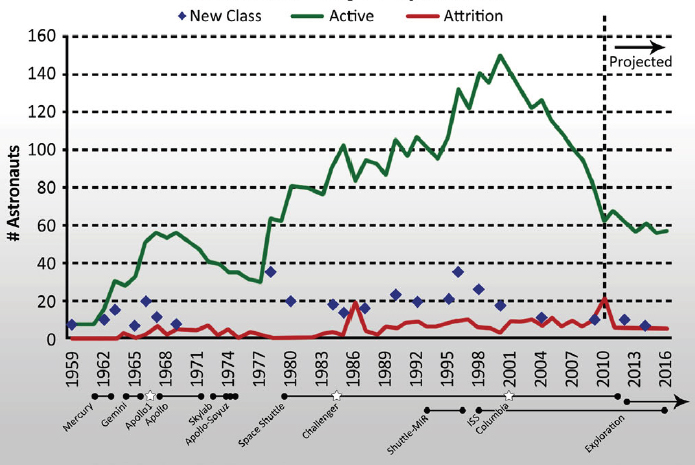
FIGURE 1.2 Historic Astronaut Corps population, December 15, 2010. SOURCE: NASA Astronaut Office, “Ensuring the Readiness of the Astronaut Corps: A White Paper,” NASA Johnson Space Center, Houston, Tex., March 25, 2011.
are notable: (1) the decrease in office size during the flight gap between Apollo and the space shuttle, (2) the increase in size with the advent of the shuttle and the ISS, (3) the decrease after the Challenger accident with its flight gap, and (4) the steady decline starting in 2000 as a result of policy decisions and an understanding that the ISS would require fewer astronauts over longer periods.
HISTORY OF ASTRONAUT CORPS SELECTION CRITERIA AND AVIATION EXPERIENCE
When they began their human spaceflight programs, the United States, the Soviet Union, and China all initially selected crews from their aviation populations, primarily high-performance jet aircraft. They initially did that for skill screening reasons, and all three countries then sought to maintain that proficiency for a variety of skill and safety reasons. The United States and Russia, however, have substantially expanded the population from which they select astronauts or cosmonauts to include those who have little or no aviation experience. Russian cosmonauts now include design engineers from Energia, the primary contractor for its spacecraft. The U.S. program includes a wide variety of scientists, engineers, and physicians.
Before Apollo, President Dwight D. Eisenhower and his advisers considered many occupations for the first astronauts, including mountain climbers, deep sea divers, and other physically risky occupations. Test pilots were chosen because their operationally fast-paced flight environment (requiring rapid and critical decision making skills) and man-machine interface skills (working in an enclosed multitasking environment) were most applicable to the rigors anticipated in spaceflight. Test pilots were also researchers who provided more than piloting skills: they
could analytically assess the performance of new vehicles. It was also determined that psychologically and from a skill point of view they had already been evaluated by the military, and this would shorten the overall training time. To a large extent, those selected to become astronauts had already been screened to determine whether they could perform in an intense and hazardous flight environment. The final determination to select military test pilots was made by President Eisenhower, notably in large part because of potential classified aspects of the program.1
Mercury
The first members of the NASA Astronaut Corps (Group I, Mercury 7) were all active-duty military test pilots or graduates of the Air Force or Navy test pilot school who had at least 1,500 hours of flying time. The Mercury astronaut training program was divided into six major topic sections:
The primary requirement, of course, is to train the astronaut to operate the vehicle. In addition, it is desirable that he have good background knowledge of such scientific areas related to space flight as propulsion, trajectories, astronomy, and astrophysics. He must be exposed to and familiarized with the conditions of space flight such as acceleration, weightlessness, heat, vibration, noise, and disorientation. He must prepare himself physically for those stresses which he will encounter in space flight.… An aspect of the training which might be overlooked is the maintenance of the flying skill which was an important factor in his original selection for the Mercury program.2
The Mercury astronauts, in addition to classroom training and travel to all the spacecraft development sites, participated in centrifuge training, flew on the parabolic aircraft, and flew high-performance aircraft. In the vernacular of the time, “high performance” was defined as jet powered and capable of supersonic speeds, aerobatics, and high-G loads or variable acceleration. Mercury astronauts also helped to test their own pressure suits in various thermal environments and under reduced pressure. (See Figures 1.3 and 1.4.)
In 1960, Lieutenant Robert Voas, a U.S. Navy Medical Service Corps officer assigned to NASA’s Space Task Group during the Mercury program, explained the aviation requirements for astronaut training in the early years of NASA’s human spaceflight program:
One of the continuing problems in training for space flight is the limited opportunity for actual flight practice and proficiency training. The total flight time in the Mercury capsule will be no more than 4 to 5 hours over a period of 3 years for each astronaut. The question arises as to whether all the skills required in operating the Mercury vehicle can be maintained purely through ground simulation. One problem with ground simulation relates to its primary benefit. Flying a ground simulator never results in injury to the occupant or damage to the equipment. The penalty for failure is merely the requirement to repeat the exercise. In actual flight operations, failures are penalized far more severely. A major portion of the astronaut’s tasks involves high level decision making. It seems questionable whether skill in making such decisions can be maintained under radically altered motivational conditions. Under the assumption that vigilant decision making is best maintained by experience in flight operations, the Mercury astronauts have been provided with the opportunity to fly high-performance aircraft. The program in this area is a result of their own interest and initiative and is made possible by the loan and maintenance of two F-102 aircraft by the Air Force.…
Finally, it seems important to reiterate the requirements for reproducing adequate motivational conditions in the training program. The basic task of the astronaut is to make critical decisions under adverse conditions. The results of the decisions he makes involve not just minor discomforts or annoyances, but major loss of equipment and even survival. Performance of this task requires a vigilance and decision making capability difficult to achieve under the
_________
1 “The inherent riskiness of space flight and the potential national security implications of the program, pointed toward the use of military personnel. It also narrowed and refined the candidate pool, giving NASA a reasonable starting point for selection. It also made good sense in that NASA envisioned the Astronaut Corps first as pilots operating experimental flying machines, and only later as working scientists.” John Logsdon and Roger Launius, eds., Exploring the Unknown, Volume VII, Human Spaceflight: Projects Mercury, Gemini, and Apollo, NASA, 2008, p. 13.
2 J. Logsdon and R. Launius, eds., Exploring the Unknown, Volume VII, Human Spaceflight: Projects Mercury, Gemini, and Apollo, NASA, Washington, D.C., 2008.
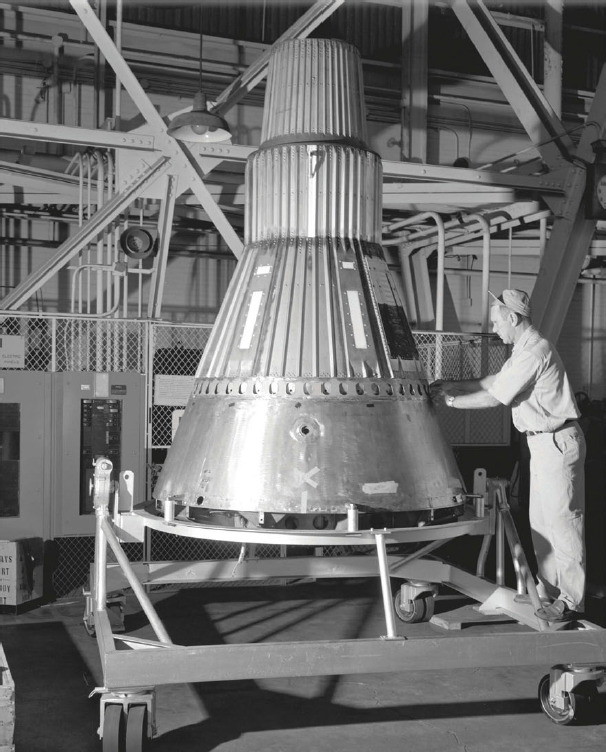
FIGURE 1.3 Mercury capsule 2 pictured at what was formerly Lewis Hangar (now Glenn Research Center) in Cleveland, Ohio. Mercury required only a single astronaut. Later spacecraft could carry more astronauts and increased the need for astronauts. SOURCE: Great Images in NASA; GPN-2000-000382; courtesy of NASA.
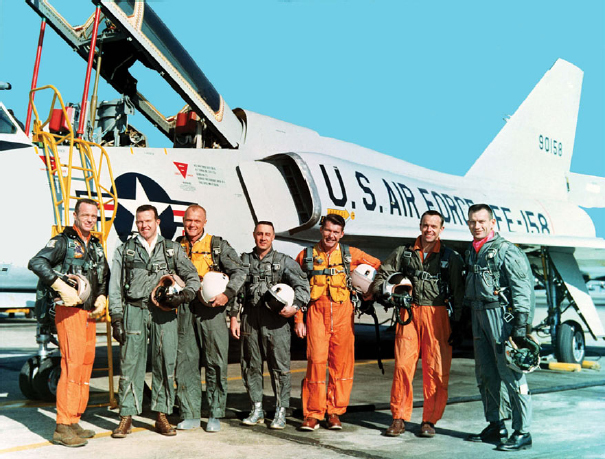
FIGURE 1.4 The Mercury 7 astronauts pose beside an F-106B Delta Dart. SOURCE: Courtesy of NASA; GPN-2000-001286, available at http://grin.hq.nasa.gov/.
artificial conditions of ground simulation. It appears probable that training in ground devices should be augmented with flight operations to provide realistic operational conditions.3
When the Astronaut Corps reached 24 active pilots, the Manned Spacecraft Center recognized the need for a regular squadron of planes to keep the crew flying skills sharp.4 Astronauts were flying in a limited fleet of T-33s and F-102s, but NASA finally narrowed down the selection of permanent aircraft to the F-4 Phantom and the T-38 Talon. They decided on the T-38 because of cost and the fact that it was a well-supported U.S. Air Force (USAF) trainer. The Air Force loaned NASA 5 T-38s in early 1964, but NASA quickly purchased a fleet of 25 T-38s. The fleet of T-38 aircraft was maintained by NASA at the former Ellington Air Force Base near Johnson Space Center. The aircraft were eventually used by both the professional pilot astronauts and the scientist-astronauts to introduce and maintain skills deemed necessary for successful and safe spaceflight; this activity became known as spaceflight readiness training (SFRT).
_________
3 R.B. Voas, NASA Space Task Group, “Project Mercury Astronaut Training Program,” May 30, 1960, Document I-31, pp. 161-172, in Exploring the Unknown, Volume VII, Human Spaceflight: Projects Mercury, Gemini, and Apollo(J. Logsdon and R. Launius, eds.), NASA, Washington, D.C., 2008.
4 D. Slayton and M. Cassutt, Deke!, Forge Books, Tom Doherty, Inc., New York, N.Y., 1995, p. 142.

FIGURE 1.5 The Gemini program not only increased the number of astronauts that were required for each spacecraft but added new operations, such as rendezvous, that increased training requirements. Here is a multiple exposure of the Gemini Rendezvous Docking Simulator. SOURCE: Courtesy of NASA/William Salyer; GPN-2000-001278, available at http://grin.hq.nasa.gov/.
Gemini and Apollo
With the approval of the Apollo program in May 1961 and the projected need for astronauts who would fly the missions (and play a lead role in hardware development and in the development of new procedures, such as rendezvous and docking), the agency returned to the test pilot pool for its next selection; this time, however, civilians, including NASA employees, were allowed to apply. Nine new astronauts were selected in September 1962 (Group II), bringing the total Astronaut Office size to 16. (See Figures 1.5, 1.6, 1.7, and 1.8.)
NASA preferred to select experienced test pilots as astronauts, not just for their proven ability to operate in high-stress environments but for their engineering expertise in high-tech development programs. Group II included two civilians who had military test flying experience, four men from the Air Force, and three from the Navy. Three had master’s degrees in engineering, four had bachelor’s degrees in engineering, and two had bachelor’s degrees in science from the Naval Academy.
Believing that the program needed an Astronaut Corps of 24 to crew Gemini and Apollo, NASA management conducted a new recruitment in 1963 (Group III) that gave preference to test pilots but allowed for the selection of candidates with only 1,000 hours of high-performance jet flying time. Fourteen new astronauts were announced in October 1963, bringing the total Astronaut Office head count to 30. Group III included eight holders of advanced degrees and two civilians.
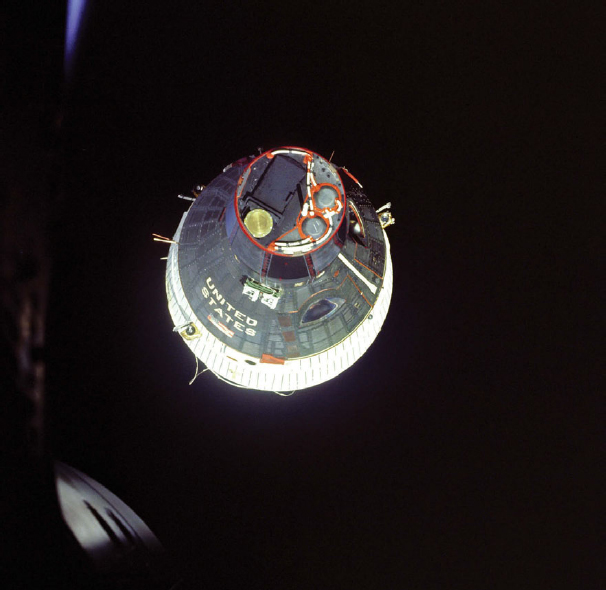
FIGURE 1.6 The Gemini 7 spacecraft as observed from the Gemini 6 spacecraft during rendezvous maneuvers. SOURCE: Courtesy of NASA; GPN-2000-001049, available at http://grin.hq.nasa.gov/.
Scientist-Astronauts and the Apollo Applications Program
With encouragement from the National Academy of Sciences and other outside agencies, beginning in 1964, NASA began to consider the selection of scientists as astronauts for Apollo lunar exploration and Earth orbital missions. Candidates for the scientist-astronaut position could be but were not required to be pilots. The candidates were required to hold a doctoral degree in medicine, engineering, or one of the natural sciences. The National Academy of Sciences screened and evaluated the applications for scientific criteria, and NASA made the final selection.
Of the six candidates selected in June 1965 (Group IV), two were experienced pilots. The other four, as planned, were sent to USAF undergraduate pilot training for a year to qualify in the T-38, which NASA had adopted as its primary aircraft. One candidate withdrew from the program during flight school.
In 1965 and 1966, NASA’s long-term schedule called for as many as 30 Apollo Extension Program (AEP) or Apollo Applications Program (AAP) missions from 1969 to the middle 1970s. The agency therefore conducted a new round of selections in two phases: First, a new group of pilot-astronauts were selected according to the same
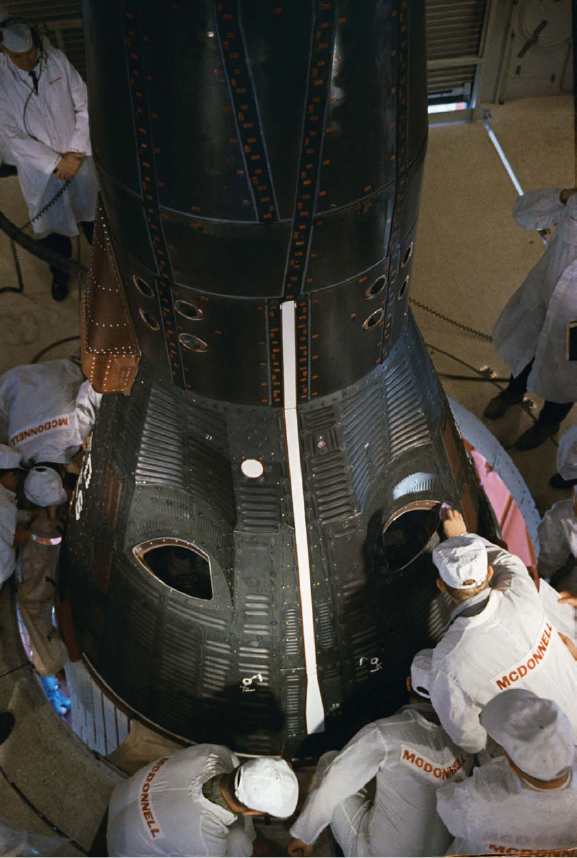
FIGURE 1.7 Technicians make final inspections of the Gemini 3 spacecraft in the spacecraft preparation room at Kennedy Space Center. SOURCE: Courtesy of NASA; GPN-2006-000016, available at http://grin.hq.nasa.gov/.
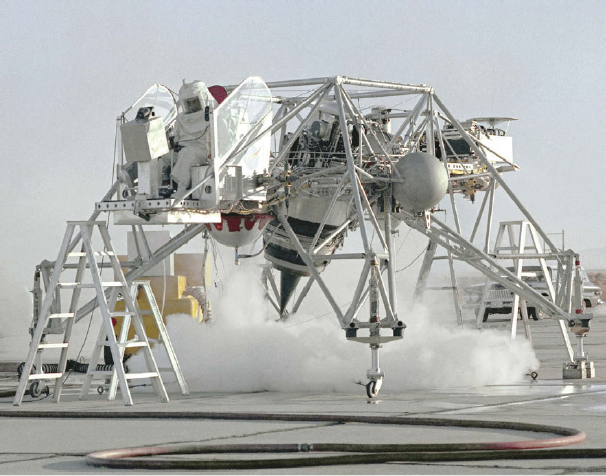
FIGURE 1.8 NASA’s Lunar Landing Research Vehicle during an early test. New programs and spacecraft required the development of new ground and flying simulators. SOURCE: NASA Dryden Flight Research Center; ECN-448, available at http://nix.ksc.nasa.gov/.
criteria as the October 1963 class. Nineteen (Group V) were announced in April 1966 and included 11 holders of advanced degrees.
A second group of 11 scientist-astronauts (Group VI), selected according to the same standards as the June 1965 group but with NASA taking a more active role in the early screening, were announced in August 1967. In spring 1968, they commenced flight school. It was the first class to contain no military astronauts. Two dropped out during this phase, and the remaining nine reported back to Houston in summer 1969.
During the later Apollo program, after scientist-astronauts were selected (at the insistence of Congress), all non-pilot-astronauts were sent to Air Force flight school for 1 year. When skills related to scientific research, flight engineering, or flight medicine were required and the skilled people did not have aviation experience, NASA management believed that it was necessary for them to acquire the skills and learn how to function in a realistic operational environment. (See Figures 1.9, 1.10, 1.11, 1.12, and 1.13.)
Flight school was also, in itself, part of the selection process. Specifically, not all scientist-astronauts selected for the Astronaut Office and sent to flight school decided to continue in the Corps after that experience.
Apollo 1 Fire in 1967 and Implications for the Astronaut Corps
On January 27, 1967, the Apollo 1 capsule caught fire on the pad at the Kennedy Space Center. Astronauts White, Grissom, and Chaffee perished. Immediately after, NASA convened the Apollo 204 Accident Review

FIGURE 1.9 Apollo 13 astronauts practice a moonwalk at Kennedy Space Center. SOURCE: Courtesy of NASA; GPN-2002-000053, available at http://grin.hq.nasa.gov/.

FIGURE 1.10 Astronaut Alan L. Bean near a tool carrier during an EVA on the Ocean of Storms. SOURCE: Courtesy of NASA/ Charles Conrad, Jr.; GPN-2000-001428, available at http://grin.hq.nasa.gov/.
Board. One result of the accident was that the Astronaut Office became even more integrated into the design and development of the Apollo vehicles (Figure 1.14).
The Astronaut Office size, on July 20, 1969, when the first lunar landing occurred, was 57, more than sufficient for the projected and budgeted Apollo and post-Apollo missions. In late 1969, despite possibly possessing more astronauts than available flight opportunities, NASA agreed to an Air Force request to accept astronauts from the recently canceled Manned Orbiting Laboratory (MOL) program. Seven of the 14 men—all military test pilots—joined the Astronaut Corps, bringing its total size in late 1969 to 64 (Group VII).
Over the next 6 years, as Apollo 13-17 and Skylab 2-4 flew, the Astronaut Corps began to shrink in size: by 1976, a year after Apollo-Soyuz and at least 6 years before the shuttle flights, there were fewer than 30 active astronauts. Most of the attrition was due to astronauts’ completing their missions and moving on to other careers, but some astronauts never flew in space and left for various reasons.
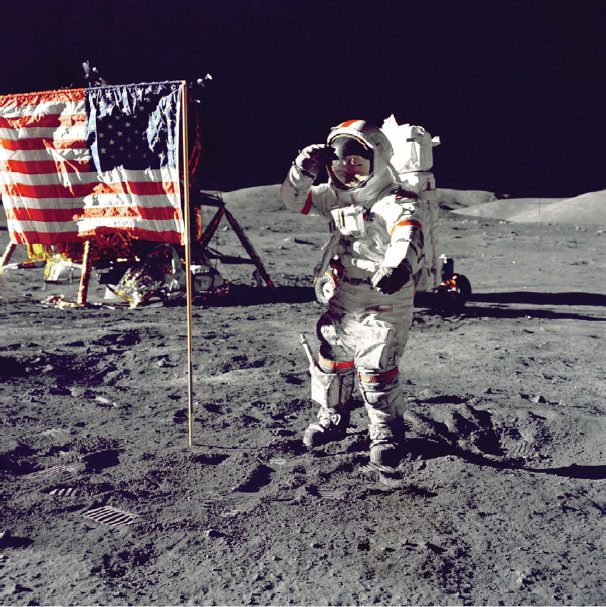
FIGURE 1.11 Astronaut Eugene A. Cernan of Apollo 17 salutes the flag on the Moon during an EVA. SOURCE: Courtesy of NASA/Harrison Schmitt; GPN-2000-001273, available at http://grin.hq.nasa.gov/.
The Shuttle Era: 1978-1986
By 1972, when the space shuttle contract was awarded to Rockwell International, NASA began planning for a new type of astronaut to fly on and operate the space shuttle. A NASA selection panel developed criteria for two types of NASA astronauts: pilots and mission specialists. Pilots would serve as commanders and pilots for shuttle missions. They could be military or civilians. Test pilot qualification was not mandatory but was preferred. Mission specialists would operate the Remote Manipulator System (RMS, the shuttle arm) and conduct extravehicular activities, scientific and engineering research, and other non-flying tasks. Mission specialists could be engineers, scientists, or physicians; they could be civilian or non-rated (nonpilot) military personnel (military mission specialists were pilots who lacked the experience for the shuttle pilot position, flight engineers, Navy divers, and so on).
During this period, NASA made an effort to recruit women and minority-group members. Both the White
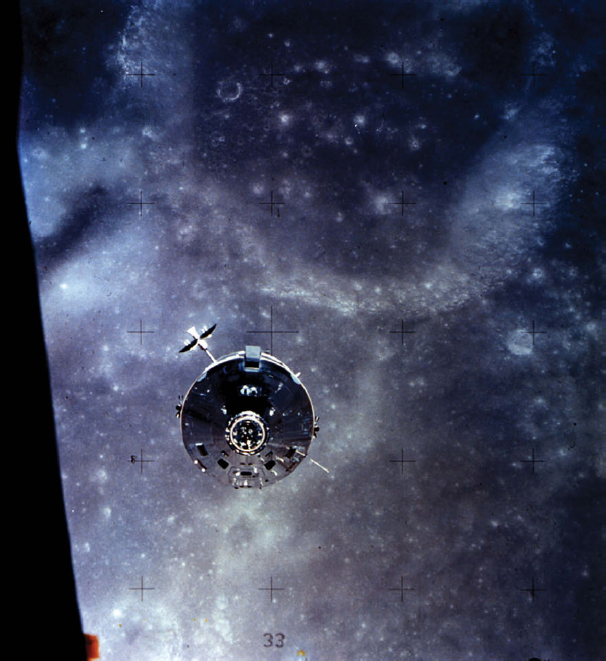
FIGURE 1.12 Apollo 16 Command and Service module over the Moon. SOURCE: Courtesy of NASA; GPN-2002-000069, available at http://grin.hq.nasa.gov/.
House and NASA believed that the Astronaut Office should “look like America.” To ensure that the broadest population possible could apply, the space shuttle physical anthropometric standards were enlarged to allow larger men (95th percentile) and smaller women (5th percentile).
Pilot astronauts would be required to maintain high-performance proficiency in the T-38. Mission specialists were required to qualify as backseat T-38 crew members (Figure 1.15).
At that time, NASA also developed plans for a third type of astronaut, the payload specialist. Payload specialists were not career astronauts; they were to be selected as needed for specific missions (Spacelab, military payloads, commercial satellite deployments, and international payloads), fly once, and then return to their other
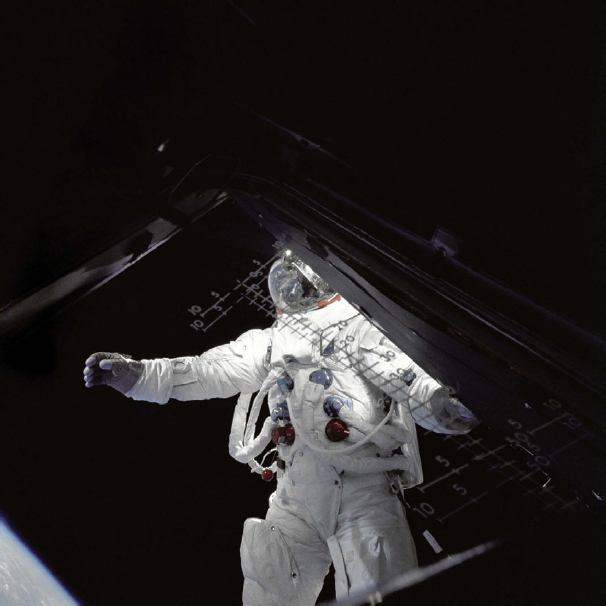
FIGURE 1.13 Astronaut Russell L. Schweickart stands on the Lunar Module’s “Spider” porch during an EVA on the Apollo 9 mission. SOURCE: Courtesy of NASA/James McDivitt. GPN-2000-001108, available at http://grin.hq.nasa.gov/.
jobs. They would not be trained to operate the RMS or to do EVAs, nor would they fly the T-38, except for one or two “familiarization” rides with their mission commanders.
In 1978-1986, approximately 60 payload specialists were trained at JSC. Flights dedicated to research trained up to four payload specialists for each mission position; one or two primary payload specialists were selected within 6 months of flight by the payload investigator working group in consultation with the Astronaut Office. The Astronaut Office had veto power if it concluded that an astronaut was not “safe” enough to function in the dynamics of the spaceflight environment or as an integral part of the crew.
The Astronaut Corps in 1985 was just large enough to support the flight rate and crew training template. In some cases, mission specialists in particular were rotating from one flight to training for another flight with only a few weeks in between.
In January 1986, the NASA Astronaut Corps had over 100 active members; this was considered barely adequate
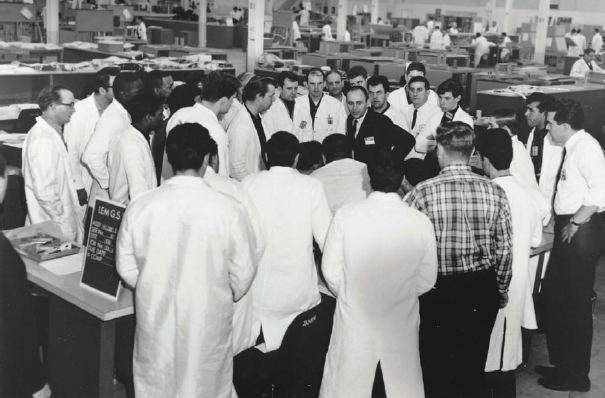
FIGURE 1.14 Astronaut Alan Bean speaking to engineers at Grumman, the manufacturer of the Lunar Module, in 1966. After the January 1967 Apollo 1 fire, astronauts became more integrated into the design and development of the spacecraft that they would fly. SOURCE: Courtesy of Northrop Grumman History Center.

FIGURE 1.15 T-38N jets in flight over NASA’s Dryden Flight Research Center in California. SOURCE: NASA/Jim Ross; ED07-0222-06, available at http://www.nasa.gov/centers/dryden/multimedia/.
to staff and support a shuttle flight rate of 8-10 missions per year and proposed space station missions. A new selection was planned for 1986 when the Challenger accident occurred.
The Challenger Accident in 1986 and Implications for the Astronaut Corps
After Challenger, the Space Shuttle program was grounded until return to flight in 1988, and almost all astronauts were assigned to various technical jobs to support the investigation and the recertification of the space shuttle and all its components. The Teachers in Space program largely ended, but payload specialists were still being selected. Anticipating the continuation of the Space Shuttle program and the space station, NASA continued to recruit.
The investigation report made clear recommendations about including astronauts into more support roles in the management structure to ensure mission safety. Some astronauts accepted temporary assignments into field center and Headquarters positions, and others eventually left their flight careers to accept permanent civil service positions.
The Post-Challenger Shuttle Era: 1988-2011
In mid-1993, NASA and the newly formed Russian Space Agency (RSA) signed an agreement to initiate a joint program to dock the space shuttle to the Mir space station in the expectation that RSA would join the International Space Station. The new project also called for U.S. support astronauts in Star City who had to acquire Russian language skills, and this eventually became a training opportunity for future Mir crew selection. The project required more astronauts than had been anticipated in the staffing models, and Russian language was added to the NASA astronaut training curricula. (See Figures 1.16, 1.17, and 1.18.)
The ISS Era
With the development of the International Space Station (an ISS training cycle could take 4 years for each astronaut) came the expectation that astronauts would again be required and expected to support the new vehicle design. The agency was flying four or five shuttle missions each year in addition to ISS expeditions, and the Astronaut Office reached its peak staffing size of nearly 150 in 1999. Mission support was intense and geographically diverse. The planet-wide geographical spread of training strained crew time to support ISS design and safety boards at the various NASA centers. (See Figure 1.18.)
By 2004, however, the Columbia accident and the planned end of the Space Shuttle program caused NASA to slow and shrink astronaut candidate recruitments. Eleven were selected in June 2004; these were the first astronaut candidates to be told that they might not fly on a shuttle (all did). An additional nine were selected in June 2009. (See Figures 1.19 and 1.20.)
HISTORY OF THE ORGANIZATIONAL STRUCTURE AND ROLE OF THE ASTRONAUT OFFICE
The Astronaut Office is a part of the Flight Crew Operations Directorate, which also includes Aircraft Operations. This structure has matured over the last 40 years but has varied little.
The Astronaut Office, like many other flight crews in “test and development” organizations, is internally organized to support both the ongoing missions with trained crew (this drives the office size) and mission development and safety. Many of the roles would be considered normal operations in other flight test organizations, such as the Air Force Flight Test Center at Edwards AFB, California, the Navy Flight Test Center at Patuxent River, Maryland, and the commercial Boeing test flight program in Seattle, Washington. Astronauts are required to sign off on multiple steps of the safety process, including the Certification of Flight Readiness (CoFR), before each spaceflight.
Although selected to support the mission manifest, the Astronaut Corps is also used as subject matter experts in the development of future spacecraft and research payloads by providing design expertise and lessons learned. Astronauts selected for specific engineering or scientific expertise (such as materials scientists, astronomers, and
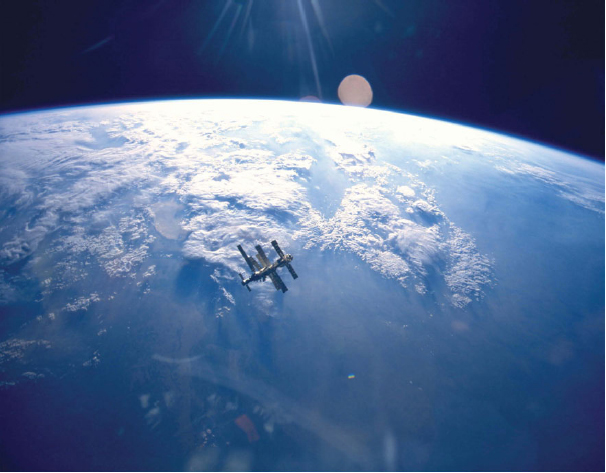
FIGURE 1.16 Russia’s Mir Space Station seen against a blue and white backdrop of Earth by the space shuttle Atlantis after undocking in June 1995. SOURCE: Courtesy of NASA; available at http://spaceflight.nasa.gov/history/shuttle-mir/multimedia/sts-71-photos/71p-021.htm.
physicians) were assigned to help in the design of payloads or experiments and engineering tests identified for flight.
Astronauts are also responsible for evaluation, testing, and development of new vehicle designs, hardware, and operations (such as the rapid prototyping laboratory). They formally sit on and are voting members of a number of design and safety boards. They are integral to the development of flight procedures, which generally change with each mission.
HISTORY OF NASA GROUND TRAINING FACILITIES AND ALLOCATION FOR SPACEFLIGHT READINESS TRAINING
Astronaut training must cover a wide array of skills, which require a variety of training facilities. The definition, design, and funding of ground-based simulators is the responsibility of an organization in the Mission Operations Directorate (MOD). MOD is also the parent organization of the Mission Control Center (MCC) and its flight controllers. MOD works with the Astronaut Office in the development of simulator and training requirements. Until the late 1980s, MOD was also in FCOD.
Computer-driven simulators were first developed in support of the Mercury, Gemini, and Apollo programs (Figures 1.21 and 1.22). Many of the simulators, including the ones for the Lunar Module and the Lunar Rover,

FIGURE 1.17 Crew members from STS-71, Mir-18, and Mir-19 pose for an in-flight picture. SOURCE: Courtesy of NASA; GPN-2002-000061, available at http://grin.hq.nasa.gov/.

FIGURE 1.18 The International Space Station orbiting Earth as seen from STS-102. SOURCE: Courtesy of NASA, available at http://mix.msfc.nasa.gov/abstracts.php?p=1644.
were primarily mechanical emulators. Others, such as the capsules, were high-fidelity physical environments and could cause instruments and surrounding environments to emulate both normal operations and emergency operations. The training organization strove to keep the trainers under configuration control so that there would be no surprises for the crew when they operated the real vehicle.
The MOD Training Division works closely with FCOD to ensure that simulators and other trainers provide the appropriate fidelity, and both MOD and FCOD are responsible for ensuring that crews pass training tests before flight. The introduction of each new spacecraft and new tasks (such as EVAs and rendezvous and docking) led
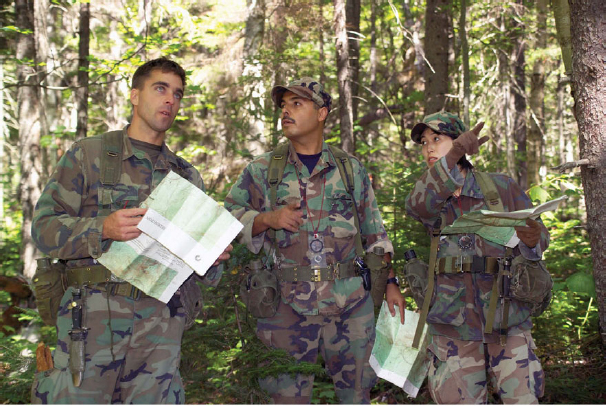
FIGURE 1.19 NASA astronaut candidates Christopher Cassidy (left), Jose Hernandez (middle), and Japan Aerospace Exploration Agency astronaut Naoko Yamazaki (right) practice their navigation skills. SOURCE: Courtesy of NASA Johnson Space Center Features; available at http://www.jsc.nasa.gov/jscfeatures/articles/000000255.html.
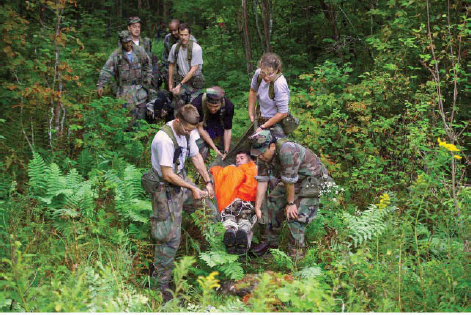
FIGURE 1.20 NASA astronaut candidates conduct an emergency egress drill during land survival training. SOURCE: Courtesy of NASA Johnson Space Center Features; available at http://www.jsc.nasa.gov/jscfeatures/articles/000000255.html.
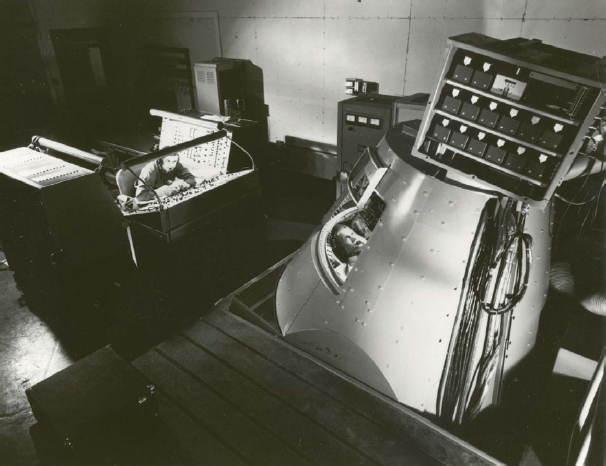
FIGURE 1.21 Astronaut John H. Glenn in the Mercury Procedures Trainer. SOURCE: Courtesy of NASA; GPN-2002-000044, available at http://grin.hq.nasa.gov/.
to the introduction of new training equipment and facilities to support them. Many of the facilities were at the Johnson Space Center; others were at NASA centers across the country (Figure 1.23). Over time, astronaut training facilities were consolidated at JSC, including the Neutral Buoyancy Laboratory (NBL), the large swimming pool used by astronauts to train for EVAs. The shuttle era introduced a large number of facilities and trainers to train astronauts in such diverse tasks as flying and landing the shuttle, operating the RMS, conducting emergency procedures, EVA preparation, operating the Spacelab, and using various shuttle systems.
The ISS era had a major impact on the requirements for training facilities. Each new ISS segment could, in effect, be considered a new spacecraft. Astronauts needed to train for basic ISS tasks, such as stowing equipment, and more advanced tasks, such as operating system and science software and maintaining complex ISS systems. These different requirements resulted in the development of both low-fidelity and high-fidelity ISS simulators. ISS training was also complicated by the introduction of international components, such as laboratory modules, and new, non-U.S. spacecraft, such as the Soyuz. In general, NASA adopted a policy of having low-fidelity mockups of international equipment at JSC and sending astronauts overseas to the international partners who possessed the high-fidelity trainers and equipment (Figure 1.24).
Ground-based simulators for space fight missions are used for 90-95 percent of training. As little as 5 percent of crew training time is spent with SFRT in preparing for a mission, but it is considered by FCOD to be a critical part of crew training and the primary distinction between preparing for an Earth-based mission and one in space.
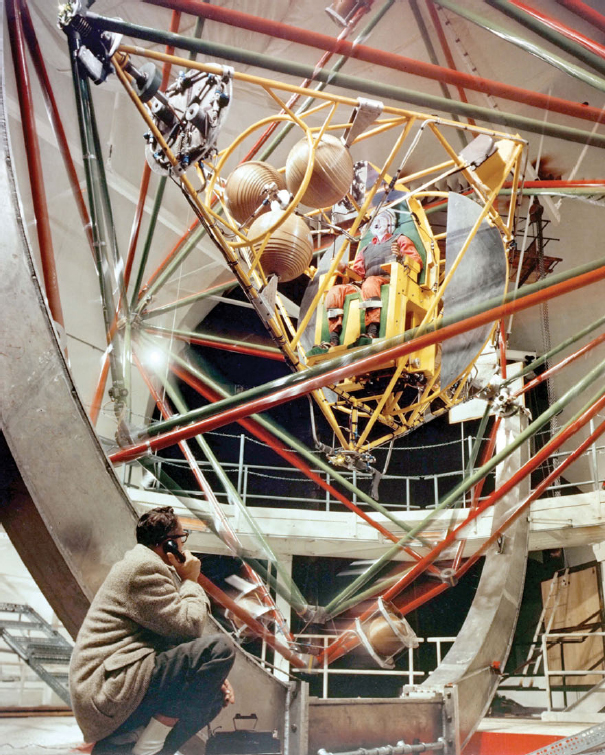
FIGURE 1.22 The Project Mercury altitude wind tunnel gimbaling rig. SOURCE: Courtesy of NASA/Bill Bowles; GPN-2000-000385, available at http://grin.hq.nasa.gov/.
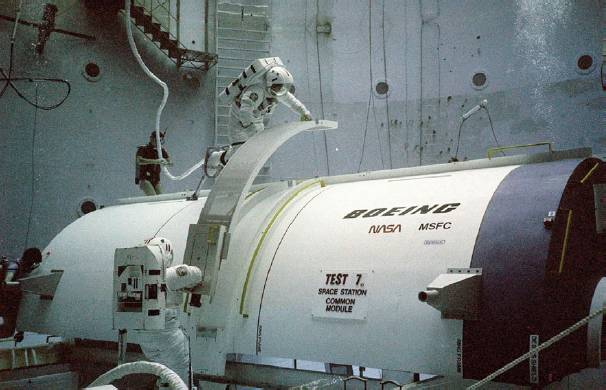
FIGURE 1.23 Two astronauts practice construction techniques to build a space station in the Neutral Buoyancy Simulator at Marshall Space Center in 1985. In the 1990s, EVA training was consolidated at the Johnson Space Center. SOURCE: Courtesy of NASA/Dennis Keim; GPN-2000-000057, available at http://grin.hq.nasa.gov/.
Apart from SFRT, small environmental additions to flight training include exposure to hypoxia in the JSC high-altitude chamber, a one-time run in the Russian centrifuge at Star City (for medical evaluation after exposure to ballistic re-entry), and survival training (water and land).
The U.S. astronaut program has evolved over the decades to meet the needs of the new activities initiated by NASA. But it has also adapted to new social and political realities. The program has incorporated non-test pilots, scientists, a much broader demographic base, international participants, and other groups. Changes in training have been driven not only by the introduction of new spacecraft and requirements but by the need to accommodate astronauts whose experience is different from that of test pilots. Now, with the shuttle retired and the ISS having entered its fully operational phase, the agency is undergoing a new, and uncertain, transformation, which will also have implications for the Flight Crew Operations Directorate, the Astronaut Office, and the Astronaut Corps.

